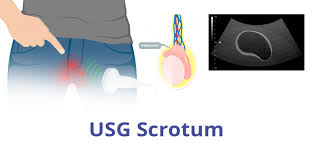
USG (SCOROTAL)
Scrotal ultrasound procedureAbout USG (SCOROTAL)
A scrotal ultrasound, also known as a testicular ultrasound, is a safe and painless imaging technique that uses sound waves to create detailed pictures of a male's scrotum, testicles, and the surrounding tissues.
Scrotal ultrasound procedure
Here's what a scrotal ultrasound typically involves:
-
Purpose: A scrotal ultrasound is primarily used to diagnose and evaluate conditions related to the testicles and scrotum. Some common reasons for a scrotal ultrasound include:
- Testicular pain or swelling
- A lump in the scrotum
- Infertility
- Undescended testicles (testes that haven't moved down into the scrotum from the abdomen before birth)
- Varicocele (enlarged veins in the scrotum)
- Hydrocele (fluid collection around the testicle)
- Torsion (twisting of the spermatic cord that cuts off blood flow to the testicle)
- Following an injury to the scrotum
-
Procedure: The scrotal ultrasound is a relatively simple and quick outpatient procedure. During the exam:
- You will likely be asked to lie on your back with your legs spread apart on an examination table.
- A sonographer will apply a warm gel to your scrotum.
- The sonographer will then gently glide a handheld transducer (probe) over the gel-coated scrotum. The transducer emits sound waves that bounce off your testicles and other structures, creating images on a nearby screen for the doctor to examine.
- The entire procedure typically takes about 15-30 minutes.
Benefits of a Scrotal Ultrasound:
- Safe and painless: A scrotal ultrasound is a non-invasive procedure that doesn't involve radiation. It usually causes minimal to no discomfort.
- Quick and effective: The ultrasound is a relatively quick procedure that can provide valuable information about the testicles and scrotum.
- Early detection: Early detection of testicular abnormalities can lead to better treatment outcomes.
Things to consider:
- Limitations: While a scrotal ultrasound is a valuable diagnostic tool, it may not always provide a definitive diagnosis in all cases.
- Follow-up tests: Depending on the results of the ultrasound, your doctor might recommend additional tests such as a blood test or biopsy for further evaluation.
Overall, a scrotal ultrasound is a safe and effective way for doctors to examine the scrotum and testicles. If your doctor recommends a scrotal ultrasound, discuss any questions or concerns you may have about the procedure.